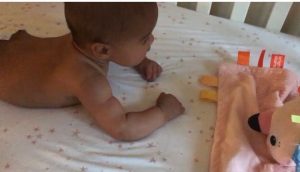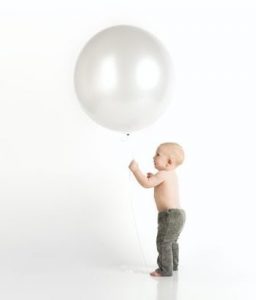…by Holly Putnam Bacasa, PT
Head Flatness in Babies

Do you have concerns about your baby’s head shape? Does you baby’s head have a flat spot? Here you will find the What’s, Why’s and How’s about head flatness in babies. What are the most common types of head flatness? What are some possible consequences of head flatness? Why does head flatness happen? How can head flatness in babies be prevented?
I see it all of the time as an pediatric Early Intervention Physical Therapist, and I’ve got some great information that I want you to know! So here’s the scoop I share with the families I am privileged to help…..
Did you know that a baby’s head could get a flat spot?
Who knew? Before I go on, let me stress that this is fixable, so keep reading!…..
A baby’s skull essentially has some mobility between the plates, and this is what helps them get through the birth canal. Makes sense right? The bone is soft and the plates of the skull are most mobile in the first three months of life, and in general, up until they are one year. I personally believe there is potential for mobility after one year, but that’s another discussion….
Your baby can simply develop flatness on an area of their skull if that spot receives more pressure than other areas.
Think Out Of the Box!
….If a baby developed a flat spot then they had to have also developed a rounded spot, right? No one came and took something away from their head to create that flat spot. Their head has the same volume it always had- it just got pushed to a new area. This is very similar to pressing a side of a balloon against the floor to flatten it a bit, and watching the air just go to a new place.
AND be assured that head flatness is not causing brain damage! It is, however, causing flatness that can possibly lead to developmental and cosmetic concerns.
WHAT IS PLAGIOCEPHALY?
This is asymmetric (offset to one side) head flatness– usually flatness noted to occur on the back of the left or the right side of the head. I have seen this cause the head to be wider than typical. Depending on the direction of the pressure, I have also seen some of the baby’s head volume be pushed upward toward the top of the back of their head. Sometimes it can be difficult to wear a properly fitting sports helmet with these results of the flatness.
WHAT CAN PLAGIOCEPHALY CAUSE?
I have seen many many cases of head flatness in my years as a PT and an Early Intervention evaluator. Of course every baby’s flatness is different. I am not sharing this information to scare you, just to let you know what is possible- real things that I see.
Here are some potential consequences of asymmetrical head flatness…
- Baby may develop a tight neck muscle, which may get diagnosed as torticollis, from turning their head toward the flat spot.
- Baby may develop an early muscle imbalance in their neck due to their neck tightness.
- Baby may not move their head back and forth smoothly across midline while following moving objects
- Baby may develop more strength in their eyes to one direction more than another- remember that eyes are moved by muscles!
- Baby may develop an early hand/arm dominance or preference with grasping and reaching
- Baby may have uneven ear alignment due to the flatness causing pressure at the back of the ear, pushing that ear forward
- Baby may have a bulging forehead on the same side of the flatness due to the pressure on the back of the head, pushing the ear and skull forward
- Baby’s eye on flat side may look larger, and this may be due to the bony orbit of the eye forming with a larger diameter, due to the pressure on the back of the head, pushing the ear and skull forward. (An enlarged eye orbit can affect peripheral vision on that side.)
- Baby’s head may be difficult to fit with a sports or safety helmet when they get older due to the shape
- May be hard to fit eye glasses if ears are not aligned.
- Depending on age and amount of head flatness, baby may qualify to receive a positioning helmet to improve their head shape. This typically starts at 6 months of age, so let’s focus on prevention!

Let’s talk about this picture– it’s a classic position that I see…. I am sure baby is comfortable and cozy as he lays and explores his mouth and face…..See how his head is turned to the right and also tilted to the left? If he really likes this position of his head and neck and it becomes a habit or a preference (meaning he doesn’t move it to the other side), then the back of the right side of his head is going to get flat. He is also going to get a tight neck muscle on the left side due to his preferred turn and tilt.
WHAT IS BRACHIOCEPHALY?
This is symmetric head flatness- noted to occur across the back of the head.
WHAT CAN BRACHIOCEPHALY CAUSE?
- Baby may develop tight neck muscles on both sides due to lack of turning their head.

- Baby may develop an early muscle imbalance in their neck due to their neck tightness.
- Baby’s head may become wider than typical and be difficult to fit with a sports or safety helmet when older.
- Baby may have difficulty turning their head to the left and right smoothly across midline while following moving objects.
WHY DID MY BABY’S HEAD GET FLAT?
- In a nutshell, your baby received pressure on an area of their skull compared to other areas, and this literally pressed the skull flatter. So the ENVIRONMENT CAUSED IT, and guess what???? Use the ENVIRONMENT TO re-shape it! (Look for a future post on some great tips!)
- Baby may have pressed their head against something in utero- a twin, mom’s rib…
- Baby may have not had a lot of room in utero to move
- Baby may have just not moved much, in general, in utero, while their head was pressed against something.

- Baby may scoot themselves to edge of bassinet and press their head against it
- Baby maybe was delivered using a vacuum assist, causing a bulge on the back of their head, which then may lead them to preferring to tilt or turn away from it.
- Baby was in the birth canal for a long time

- Baby developed an early preference to turn or tilt more to one direction and this persistent pressure on their skull from any surface (mattress, floor, your arm..)caused a flat spot.
- Baby is a good sleeper and barely moves their head once you lay them down
- Baby is all swaddled up and the swaddle keeps their head very centered, causing flatness across the back

- Caregiver had a preferred feeding and carry position which pressed on a spot on the baby’s head frequently. Essentially the caregiving was not ambydextryous. I see it all of the time! Of course it’s not something you think about, plus subconsciously you are also choosing the path of least resistance. It’s easier to carry your baby in that arm, right?
- Craniosynotosis can also cause of head flatness. This is a fairly rare condition in which some plates of the skull fuse too early. The unevenness noted in the head shape often does not follow the same presentation of a baby with head flatness from plagiocephaly or brachiocephaly.
HOW DO I PREVENT HEAD FLATNESS IN MY BABY?
-
Rotisserize your baby!
Yep- that’s my made up word. Didn’t mean to shock you with my analogy but hoping it sticks with you! It means….TURN THEM! Make sure they get time to lay on all 4 sides- their back, their tummy and their right and left sides! Like this….
-
Sleep and play on their BACK


-
Supervised play and rest on their TUMMY



-
Supervised play and rest on their LEFT SIDE


-
Supervised play and rest on their RIGHT SIDE


-
-
If your baby is awake, reposition them into a new position
- at least every 20 minutes if they are still unable to move themselves, such as bouncy seat x 20 minutes, then to tummy time -let’s cross fingers that you get a few minutes, then on back on activity mat x (up to) 20 minutes. Try to avoid 2 back lying stations in a row, such as bouncy seat to swing, as these are nearly the same position.

- Give your baby things to look at on their right and left when they are awake.
- Position your baby and things that your baby likes to look at so that they turn their head equally to the right and left when they play on their back and tummy. This will help keep their head shaped well.
- at least every 20 minutes if they are still unable to move themselves, such as bouncy seat x 20 minutes, then to tummy time -let’s cross fingers that you get a few minutes, then on back on activity mat x (up to) 20 minutes. Try to avoid 2 back lying stations in a row, such as bouncy seat to swing, as these are nearly the same position.
-
Reposition & Gentle Stretching
- If baby is born with some flatness, baby can be positioned on the opposite side (off of the flat spot and on the round spot) to prevent if from getting worse and to also help reshape the head.

- Provide gentle motion to help turn your baby’s neck to keep it flexible and to help them not develop a preference for turning more to one direction

- Provide gentle motion to help tilt your baby’s neck to keep it flexible and to help them to not develop a preference for tilting it more to one direction.
- If baby is born with some flatness, baby can be positioned on the opposite side (off of the flat spot and on the round spot) to prevent if from getting worse and to also help reshape the head.
Check out my blog, “A Parents Guide To Identifying Neck Tightness or Head Flatness in Babies – The Turn-Tilt-Top Method“, to help identify if your baby could benefit from some stretching and repositioning.
 If you think your baby is developing some head flatness or have any concerns about your baby’s head shape try to reposition them. Also don’t hesitate to consult with your county’s Early Intervention Agency, as well as your pediatrician. Remember, you know your baby best! Take advantage of this window of opportunity to receive coaching in how to help your baby.
If you think your baby is developing some head flatness or have any concerns about your baby’s head shape try to reposition them. Also don’t hesitate to consult with your county’s Early Intervention Agency, as well as your pediatrician. Remember, you know your baby best! Take advantage of this window of opportunity to receive coaching in how to help your baby.
Here’s the link to Early Intervention contacts in each US state.
https://www.cdc.gov/ncbddd/actearly/parents/state-text.html

